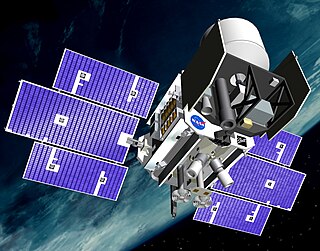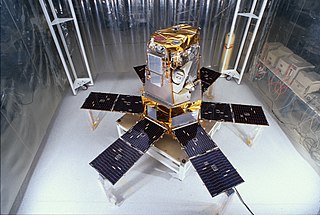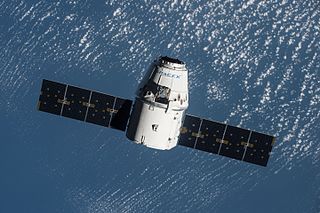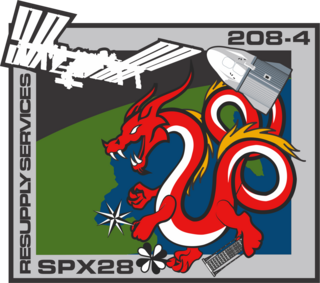
The Japanese Experiment Module (JEM), nicknamed Kibō, is a Japanese science module for the International Space Station (ISS) developed by JAXA. It is the largest single ISS module, and is attached to the Harmony module. The first two pieces of the module were launched on Space Shuttle missions STS-123 and STS-124. The third and final components were launched on STS-127.

Venera 9, manufacturer's designation: 4V-1 No. 660, was a Soviet uncrewed space mission to Venus. It consisted of an orbiter and a lander. It was launched on June 8, 1975, at 02:38:00 UTC and had a mass of 4,936 kilograms (10,882 lb). The orbiter was the first spacecraft to orbit Venus, while the lander was the first to return images from the surface of another planet.
SCISAT-1 is a Canadian satellite designed to make observations of the Earth's atmosphere. Its main instruments are an optical Fourier transform infrared spectrometer, the ACE-FTS Instrument, and an ultraviolet spectrophotometer, MAESTRO. These devices record spectra of the Sun, as sunlight passes through the Earth's atmosphere, making analyses of the chemical elements of the atmosphere possible.

Transition Region and Coronal Explorer was a NASA heliophysics and solar observatory designed to investigate the connections between fine-scale magnetic fields and the associated plasma structures on the Sun by providing high resolution images and observation of the solar photosphere, the transition region, and the solar corona. A main focus of the TRACE instrument is the fine structure of coronal loops low in the solar atmosphere. TRACE is the third spacecraft in the Small Explorer program, launched on 2 April 1998, and obtained its last science image on 21 June 2010, at 23:56 UTC.

ICESat was a NASA satellite mission for measuring ice sheet mass balance, cloud and aerosol heights, as well as land topography and vegetation characteristics. It operated as part of NASA's Earth Observing System (EOS). ICESat was launched 13 January 2003 on a Delta II launch vehicle from Vandenberg Air Force Base in California into a near-circular, near-polar orbit with an altitude of approximately 600 km (370 mi). It operated for seven years before being retired in February 2010, after its scientific payload shut down and scientists were unable to restart it.

The Solar Radiation and Climate Experiment (SORCE) was a NASA-sponsored satellite mission that measured incoming X-ray, ultraviolet, visible, near-infrared, and total solar radiation. These measurements specifically addressed long-term climate change, natural variability, atmospheric ozone, and UV-B radiation, enhancing climate prediction. These measurements are critical to studies of the Sun, its effect on the Earth's system, and its influence on humankind. SORCE was launched on 25 January 2003 on a Pegasus XL launch vehicle to provide NASA's Earth Science Enterprise (ESE) with precise measurements of solar radiation.

The Earth Radiation Budget Satellite (ERBS) was a NASA scientific research satellite. The satellite was one of three satellites in NASA's research program, named Earth Radiation Budget Experiment (ERBE), to investigate the Earth's radiation budget. The satellite also carried an instrument that studied stratospheric aerosol and gases.

Cygnus is an expendable American cargo spacecraft developed by Orbital Sciences Corporation and now manufactured and launched by Northrop Grumman Space Systems as part of NASA's Commercial Resupply Services (CRS) program. It is usually launched by Northrop Grumman's Antares rocket, although three flights were on ULA's Atlas V and three are planned to launch on SpaceX's Falcon 9. It is designed to transport supplies to the International Space Station (ISS) following the retirement of the American Space Shuttle. Since August 2000, ISS resupply missions have been regularly flown by the Russian Progress spacecraft, as well as by the European Automated Transfer Vehicle, and the Japanese H-II Transfer Vehicle. With the Cygnus spacecraft and the SpaceX Dragon, NASA seeks to increase its partnerships with domestic commercial aviation and aeronautics industry.

Commercial Resupply Services (CRS) are a series of flights awarded by NASA for the delivery of cargo and supplies to the International Space Station (ISS) on commercially operated spacecraft. The first CRS contracts were signed in 2008 and awarded $1.6 billion to SpaceX for twelve cargo Dragon and $1.9 billion to Orbital Sciences for eight Cygnus flights, covering deliveries to 2016. The Falcon 9 and Antares rockets were also developed under the CRS program to deliver cargo spacecraft to the ISS.
The Stratospheric Aerosol and Gas Experiment (SAGE) is a series of remote sensing satellite instruments used to study the chemical composition of Earth's atmosphere. Specifically, SAGE has been used to study the Earth's ozone layer and aerosols at the troposphere through the stratosphere. The SAGE instruments use solar occultation measurement technique to determine chemical concentrations in the atmosphere. Solar occultation measurement technique measures sunlight through the atmosphere and ratios that measurement with a sunlight measurement without atmospheric attenuation. This is achieved by observing sunrises and sunsets during a satellite orbit. Physically, the SAGE instruments measure ultraviolet/visible energy and this is converted via algorithms to determine chemical concentrations. SAGE data has been used to study the atmospheres aerosols, ozone, water vapor, and other trace gases.

SAGE III on ISS is the fourth generation of a series of NASA Earth-observing instruments, known as the Stratospheric Aerosol and Gas Experiment. The first SAGE III instrument was launched on a Russian Meteor-3M satellite. The recently revised SAGE III was mounted to the International Space Station where it uses the unique vantage point of ISS to make long-term measurements of ozone, aerosols, water vapor, and other gases in Earth's atmosphere.

Nanoracks LLC is a private in-space services company which builds space hardware and in-space repurposing tools. The company also facilitates experiments and launches of CubeSats to Low Earth Orbit.

Optical Payload for Lasercomm Science (OPALS) is a spacecraft communication instrument developed at the Jet Propulsion Laboratory that was tested on the International Space Station (ISS) from 18 April 2014 to 17 July 2014 to demonstrate the technology for laser communications systems between spacecraft and ground stations.

SpaceX CRS-5, also known as SpX-5, was a Commercial Resupply Service mission to the International Space Station (ISS), conducted by SpaceX for NASA, and was launched on 10 January 2015 and ended on 11 February 2015. It was the seventh flight for SpaceX's uncrewed Dragon cargo spacecraft and the fifth SpaceX operational mission contracted to NASA under an ISS resupply services contract.

SpaceX CRS-9, also known as SpX-9, is a Commercial Resupply Service mission to the International Space Station which launched on 18 July 2016. The mission was contracted by NASA and is operated by SpaceX using a Dragon capsule.

SpaceX CRS-14, also known as SpX-14, was a Commercial Resupply Service mission to the International Space Station launched on 2 April 2018. The mission was contracted by NASA and was flown by SpaceX. This mission reused the Falcon 9 first stage booster previously flown on CRS-12 and the Dragon capsule flown on CRS-8.

ISS-RapidScat was an instrument mounted to the International Space Station'sColumbus module that measured wind speeds. It was launched aboard SpaceX CRS-4 in September 2014 and operated until August 2016. ISS-RapidScat was a scatterometer designed to support weather forecasting by bouncing microwaves off the ocean's surface to measure wind speed via wind waves. It featured a 75 cm (30 in) rotating radar dish that operated at 13.4 GHz. It could collect data between 51.6 degrees north and south latitude, with a swath 900 km wide (560 mi).

Plankton, Aerosol, Cloud, ocean Ecosystem (PACE) is a NASA Earth-observing satellite mission that will continue and advance observations of global ocean color, biogeochemistry, and ecology, as well as the carbon cycle, aerosols and clouds. PACE will be used to identify the extent and duration of phytoplankton blooms and improve understanding of air quality. These and other uses of PACE data will benefit the economy and society, especially sectors that rely on water quality, fisheries and food security.

SpaceX CRS-25, also known as SpX-25, was a Commercial Resupply Service mission (CRS) to the International Space Station (ISS) that was launched on 15 July 2022. The mission was contracted by NASA and was flown by SpaceX using their reusable spacecraft, the Cargo Dragon. The vehicle delivered supplies to the crew aboard the ISS along with multiple pieces of equipment that will be used to conduct multiple research investigations aboard the ISS.

SpaceX CRS-28, also known as SpX-28, is a Commercial Resupply Service mission to the International Space Station (ISS) launched on 5 June 2023. The mission was contracted by NASA and flown by SpaceX using Cargo Dragon C208. It was the eighth flight for SpaceX under NASA's CRS Phase 2.


















